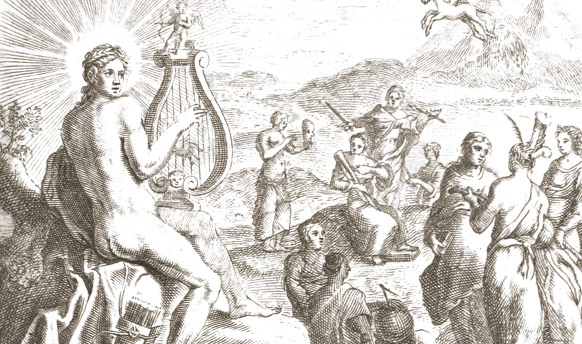
IRIS login | Reed College home Volume 90, No. 2: June 2011
Adventures in the First Person
Plate Tectonics and the Odes of Horace

Lyre, lyre, pants on fire. Was Horace guilty of cacozelia latens?
Illustration from a seventeenth century edition of the Odes.
By Mike Taylor ’62
Professor Frederic Peachy [classics 1956– 82] loved to begin class at eight o’clock in the morning. He would bounce in with a cheery, “Good morning, children!” One day a classmate got up the nerve to reply, “Good morning, Daddy,” which left him nonplussed— though only for a moment.
I read the Odes of Horace for the first time in his Latin 31 class in the fall and winter of 1961. That was the winter when a silver thaw turned a heavy snowfall on the meadow in front of Eliot Hall into an unbroken stretch of rounded hills and valleys like the mountains of the moon. I had to cross that obstacle course one morning and was glad to arrive at Professor Peachy’s office with no broken bones.
The office, which doubled as classroom, was located in an old frame structure left over from World War II (or perhaps World War I—it was hard to tell). We used to wonder what future archeologists would make of our civilization if that building was the only remnant.
Professor Peachy kept a Japanese bayonet on his desk, which he used as a letter opener. We never thought to ask exactly how he had come by it.
We spent most of Latin 31 struggling with translation and grammar, but did not look for hidden meanings because the point of each poem appeared to be obvious enough. Yes, there seemed to be an excess of fictional friends and lovers in the Odes, and sometimes the attitude of the author was hard to grasp. But after all, these were the products of another time and place, so what else could you expect?
Horace (Quintus Horatius Flaccus, 65–8 BCE) is not now as famous as his friend Virgil (Publius Vergilius Maro, 70–19 BCE), but to Latin students he is equally well known. Like the Aeneid, the Bucolics, and the Georgics of Virgil, the Odes of Horace became instant classics, the sort of stuff that every school boy and girl was made to study.
After thousands of years of scholarly examination, you might think there was little new to say about an author’s work. But you would be wrong. In 1991, Jean-Yves Maleuvre began to publish revolutionary studies proposing that Horace and Virgil both employed two layers of meaning (la double écriture)—so that they could denounce the crimes and hypocrisy of a dictator in ways that would not cost them their lives.
The tip-off to the presence of double meanings is a curious accusation by Augustus’ general Agrippa (Marcus Vipsanius Agrippa, 63–12 BCE), who said that Virgil and Maecenas (and Horace by implication) used cacozelia latens.
Cacozelia is a Greek word signifying the kind of sarcasm in which the meaning is the opposite of what the words seem to say. For example, suppose you stumbled as you walked up some steps and I remarked, “Man, you sure are graceful.” Latens is Latin for “hidden,” or “lurking.” And so we may suppose that Agrippa accused them of a kind of hidden sarcasm in which they used statements that could be taken two ways.
For example, line 256 in Horace’s Epistles, book 2, letter 1, reads et formidatam Parthis te principe Romam, which is usually understood as:
With you as leader, Rome is fearsome to the Parthians.
However, formidatus can mean either “terrified” or “terrifying,” so an alternative meaning would be:
With you as leader, Rome is terrified by the Parthians.
The ancient Romans did not use commas or quotation marks, which meant that sometimes a sentence might be taken two ways, and that an apparent monologue might actually be a dialogue. Take for example that famous quotation carpe diem, literally “pluck the day.” The full line from Odes 1.11.8 reads carpe diem quam minimum credula postero, that is, “Seize the day as little as possible believe in tomorrow.” This requires a pause in order to make the meaning clear, and scholars have traditionally placed one after diem (“day”):
Seize the day—as little as possible believe in tomorrow.
But suppose we pause instead after quam minimum (“as little as possible”)? Then the line reads:
Seize the day as little as possible—believe in tomorrow.
In other words, “Do not give yourself up to passing pleasures in despair; instead, hope for better days in the future.”
Why would Horace say that? And why be ambiguous on such a crucial point? Because Augustus was a bloody dictator. Because Horace commanded a legion for Brutus and the republican forces at the battle of Philippi in 42 BCE, when they were defeated by Augustus and Marc Antony. Although Horace enjoyed the amnesty granted to political nobodies after the reprisals were over, we should not assume that the battle changed his allegiance to the republic—or his hatred for Augustus.
Or take that other famous and oftmocked line, dulce et decorum est pro patria mori : “It is sweet and fitting to die for one’s country.” This line is found in Odes 3.2.13, where it will be seen that the eight stanzas of this poem fall easily into two groups, the first four being an exhortation to young men to do their part by valorous military service, and the last four a song in praise of true personal integrity (virtus) regardless of popular opinion. The last lines threaten criminals with divine punishment, though it may be slow in coming.
Maleuvre has a convincing explanation for the apparent lack of harmony between the two halves of the poem. In the first half, we should imagine Augustus as the speaker, and in the second half, Horace himself. Augustus was noted for cowardice (he disappeared during the first day of battle at Philippi, and was not seen again until the next day), so his appeal to bravery is hypocritical. If he is the intended speaker in the first half, there is no doubt who Horace has in mind when, in the final stanza, he warns the criminal (scelestus) that punishment will soon overtake him.
It is also clear that with praise of virtus, Horace condemns the hypocritical appeal to patriotism in the first half.
If these two odes were the only ones in which a case could be made for cacozelia latens, you might well doubt whether the poet harbored hidden animosity towards Augustus. But in fact the animosity, or something related to it, can be found in nearly every ode and also in Virgil’s Bucolics and in the Aeneid. (I chose these two odes for illustration because in these instances the case can be made briefly.)
Maleuvre’s ideas have met a rather frosty reception from the scholarly world, much as the theory of continental drift was a scientific heresy from 1596, when it was first proposed by Abraham Ortelius, until about 1960, when the theory of plate tectonics offered an explanation for it (though we should note that not everyone finds it adequate). Students who pointed out that North and South America could once have been joined to Africa and Europe were put down as naïve; scientists who suggested it were considered eccentric. Now those who oppose plate tectonics are considered eccentric!
Anyone who makes a serious study of cacozelia latens in the works of Horace and Virgil will, I think, be attracted to this new viewpoint, just as the theory of tectonic plates is more persuasive than the older notion of continents sinking (Atlantis!) and rising again from the ocean floor. Who knows—perhaps Horace will become a richer, more complex author for the students who read him tomorrow.
I think Professor Peachy would have admired Maleuvre’s thesis. Like Horace, he had the quality that Walt Whitman once described (speaking of himself, naturally) of being “in the drama, yet outside it.” He cared about people and was patient with his students. At the same time he was one of the “greatest generation,” one of the soldiers who returned from the war strengthened rather than broken.
Like Horace, he was a combat veteran, with an earthy sense of humor. (On one occasion he explained that the city of Rome had its origin when “Mars knocked up the vestal virgins.”)
Many years later, I learned that he fought with the Marines at the battle of Guadalcanal and received the Bronze Star for his service at New Britain. Like Horace and the anger that infuses his Odes, Professor Peachy came by his bayonet the hard way.
Further Reading
Petite stéréoscopie des Odes et Epodes d’Horace (2 volumes), Jean-Yves Maleuvre. J. Touzot: Paris, 1995/1997.
Cacozelia Latens, Jean-Yves Maleuvre. www.espace-horace.org
Virgil Murder, Jean-Yves Maleuvre. virgilmurder.org Life of Virgil, Suetonius.
In Memoriam: Professor Frederic Peachy. Bulletin of the Classical Association of the Pacific Northwest, 28.1, October 1997.
Clareti “Enigmata”: The Latin Riddles of Claret, Frederic Peachy. University of California Press: Berkeley, 1957.


LATEST COMMENTS
steve-jobs-1976 I knew Steve Jobs when he was on the second floor of Quincy. (Fall...
Utnapishtim - 2 weeks ago
Prof. Mason Drukman [political science 1964–70] This is gold, pure gold. God bless, Prof. Drukman.
puredog - 1 month ago
virginia-davis-1965 Such a good friend & compatriot in the day of Satyricon...
czarchasm - 4 months ago
John Peara Baba 1990 John died of a broken heart from losing his mom and then his...
kodachrome - 7 months ago
Carol Sawyer 1962 Who wrote this obit? I'm writing something about Carol Sawyer...
MsLaurie Pepper - 8 months ago
William W. Wissman MAT 1969 ...and THREE sisters. Sabra, the oldest, Mary, the middle, and...
riclf - 10 months ago